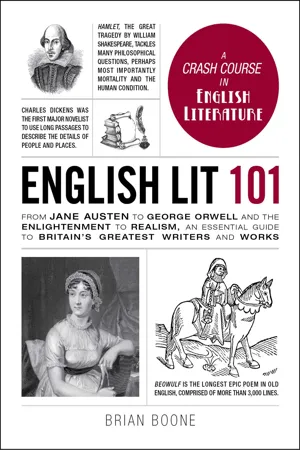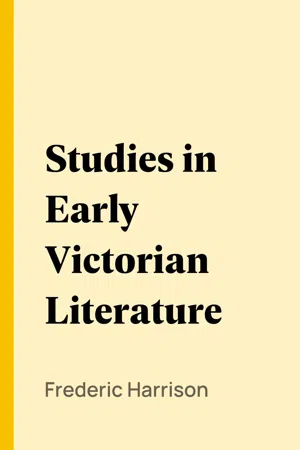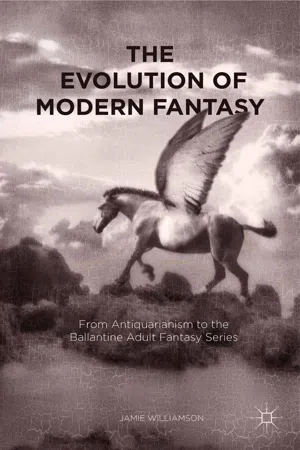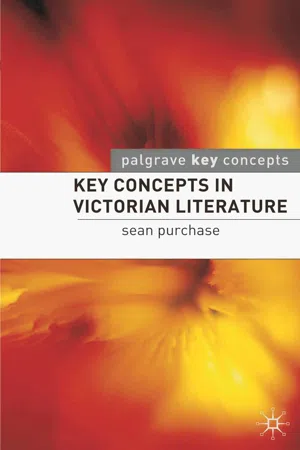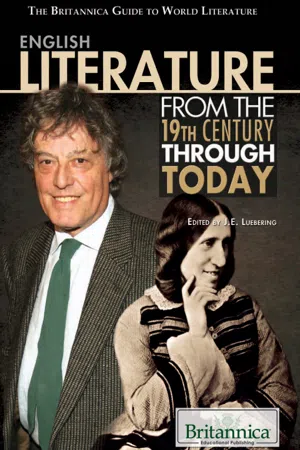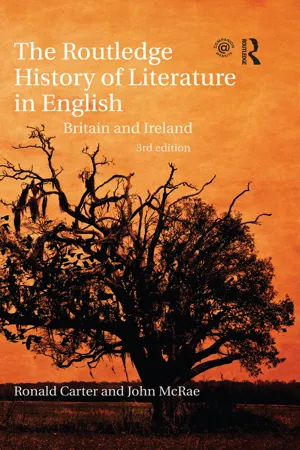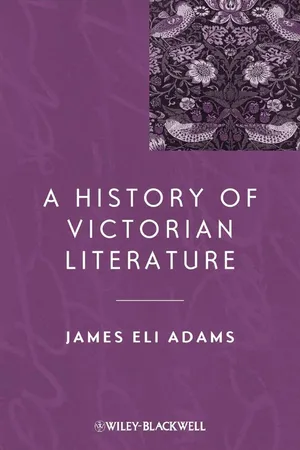Literature
Victorian Period
The Victorian Period refers to the time during the reign of Queen Victoria of England, from 1837 to 1901. This era was characterized by significant social, political, and economic changes, which greatly influenced literature. Victorian literature often reflected the moral and social concerns of the time, addressing issues such as industrialization, class struggles, and the role of women in society.
Written by Perlego with AI-assistance
Related key terms
Related key terms
1 of 4
Related key terms
1 of 3
10 Key excerpts on "Victorian Period"
- eBook - ePub
English Lit 101
From Jane Austen to George Orwell and the Enlightenment to Realism, an essential guide to Britain's greatest writers and works
- Brian Boone(Author)
- 2017(Publication Date)
- Adams Media(Publisher)
Chapter 5
The Victorian Era and the Industrial Revolution
Queen Victoria (1837–1901) had more of an influence on British society and its arts than any other monarch, and she was most definitely the last whose personal morals and choices were widely mirrored by her subjects. The Victorian era was the last time England had a monoculture, before globalism and imperialism would make the idea of “Englishness” far more complex. But writers were already exploring with wringing hands what it meant to be English in the face of an ever-changing and increasingly cruel world. That said, the incredibly structured and divided life of English society, its countless social norms, and the constant anxiety about what other people would think were informed, satirized, and questioned by the literature of the time.As the ability to read became widely possible and the printing press made books widespread and affordable, the often academic and didactic works of the great poets lost out in popularity to the real, relatable, and reality-reflecting structure and stories of prose. The novel is the legacy of previous populist authors like Henry Fielding and Jane Austen, whose stories got inside characters’ heads and put their thoughts right into the heads of readers. And, as is the case with any art, hallmarks and clichés of the form emerged. The dominant kinds of Victorian novels were adventure stories, social satire, and idealized stories in which the good guys won with luck, hard work, and love, and the bad guys were duly punished.The Victorians romanticized childhood and invented the idea of childhood being a special, specific, and innocent time of life devoted to exploration, learning, and whimsy. And thanks to sweeping school reforms, for the first time in history children were by and large literate, and publishers were happy to provide books for them. Lewis Carroll, Robert Louis Stevenson, and Charles Dickens helped establish the basic form of the children’s novel, creating first-person characters who see the world as a child does and capturing that childlike wonder. As for the adults, they wanted big, exciting stories, too. They got them with tales of mystery and the supernatural, exemplified by Sherlock Holmes, Dr. Jekyll (and Mr. Hyde), and Dracula. - eBook - ePub
- Frederic Harrison(Author)
- 2006(Publication Date)
- Perlego(Publisher)
That which in England is conveniently described as the Victorian Age of literature has a character of its own, at once brilliant, diverse, and complex. It is an age peculiarly difficult to label in a phrase; but its copious and versatile gifts will make it memorable in the history of modern civilisation. The Victorian Age, it is true, has no Shakespeare or Milton, no Bacon or Hume, no Fielding or Scott—no supreme master in poetry, philosophy, or romance, whose work is incorporated with the thought of the world, who is destined to form epochs and to endure for centuries. Its genius is more scientific than literary, more historical than dramatic, greater in discovery than in abstract thought.In lyric poetry and in romance our age has names second only to the greatest; its researches into nature and history are at least equal to those of any previous epoch; and, if it has not many great philosophers, it has developed the latest, most arduous, most important of all the sciences. This is the age of Sociology: its central achievement has been the revelation of social laws. This social aspect of thought colours the poetry, the romance, the literature, the art, and the philosophy of the Victorian Age. Literature has been the gainer thereby in originality and in force. It has been the loser in symmetry, in dignity, in grace.The Victorian Age is a convenient term in English literature to describe the period from 1837 to 1895: not that we assign any sacramental efficacy to a reign, or assume that the Queen has given any special impulse to the writers of her time. Neither reigns, nor years, nor centuries, nor any arbitrary measure of time in the gradual evolution of thought can be exactly applied, or have any formative influence. A period of so many years, having some well-known name by which it can be labelled, is a mere artifice of classification. And of course an Englishman will not venture to include in his survey the American writers, or to bring them within his national era. The date, 1837, is an arbitrary point, and a purely English point. Yet it is curious how different a colour may be seen in the main current of the English literature produced before and after that year. In the year of the Queen's accession to the throne, the great writers of the early part of this century were either dead or silent. Scott, Byron, Shelley, Keats, Coleridge, Lamb, Sheridan, Hazlitt, Mackintosh, Crabbe, and Cobbett, were gone. There were still living in 1837, Wordsworth, Southey, Campbell, Moore, Jeffrey, Sydney Smith, De Quincey, Miss Edgeworth, Miss Mitford, Leigh Hunt, Brougham, Samuel Rogers:—living, it is true, but they had all produced their important work at some earlier date. Carlyle, Dickens, Thackeray, Macaulay, Tennyson, Browning, had begun to write, but were not generally known. The principal English authors who belong equally to the Georgian and to the Victorian Age are Landor, Bulwer, Disraeli, Hallam, and Milman, and they are not quite in the very first rank in either age. It is a significant fact that the reign of the Queen has produced, with trifling exceptions, the whole work of Tennyson, the Brownings, Thackeray, Dickens, the Brontës, George Eliot, Kingsley, Trollope, Spencer, Mill, Darwin, Ruskin, Grote, Macaulay, Freeman, Froude, Lecky, Milman, Green, Maine, Matthew Arnold, Symonds, Rossetti, Swinburne, Morris, John Morley, to say nothing of younger men who are still in their prime and promise. - eBook - ePub
The Evolution of Modern Fantasy
From Antiquarianism to the Ballantine Adult Fantasy Series
- Jamie Williamson(Author)
- 2015(Publication Date)
- Palgrave Macmillan(Publisher)
4
From Verse to Prose
The Victorian Period
Introduction
A s outlined in Chapter 3 , the most significant developments during the Romantic period, leading ultimately to William Morris and the twentieth-century literary writers whose work would compose the core BAFS canon, took place in the poetic medium. Prose works, while not of negligible quality, were few; only the last, Phantasmion, closely approximates the BAFS template, and none, including Phantasmion, can be said to have exerted any noteworthy influence.The Victorian Period begins in the shadow of the Romantic period, and after a mild lull during the later 1830s and 1840s, poetic fantasy began to proliferate once more, beginning a stream that would flow until close to the end of the century. But while these poems certainly followed from the work discussed in Chapter 3 , there was a notable shift in direction. The narrative constructs were often far more expansive than even the “epics” of Southey. Where Scott invented “traditional” material, or Keats made “4000 lines of one bare circumstance,” the poets of the Victorian Period tended to interpret stories—of King Arthur, of Sigurd the Volsung—already substantially developed in their traditional redactions. One detects in this last a certain decrease in the push to invention, a certain stasis, which, while producing many popular poems, perhaps explains the sharp dwindling of such material at the century’s end.The century ends with the prose romances of William Morris, the conventional beginning of the BAFS canon. Prior to Morris, the Victorian “adult” prose fantasy pertinent here followed from that of the Romantic period in that it is fairly thin in quantity and does not consolidate into any marked pattern.The major development in Victorian prose fantasy, however, came in the context of work—loosely categorized as fairy tales—published for children. For reasons that may be in part understandable, “children’s fantasy” was, during the period of the BAFS, considered as a separate phenomenon from “Adult Fantasy.” At the same time, as noted in Chapter 1 , “children’s” and “Adult” refer more to audience than form and content, and many writers of children’s fantasy did not (and do not) consider that a projected readership including children excludes adults or that children’s fantasy cannot challenge adult readers. That the three most widely distributed collections of Victorian fairy tales since the BAFS period1 - eBook - ePub
- David Jablonsky(Author)
- 2013(Publication Date)
- Routledge(Publisher)
2 The Victorian FrameworkTensionI was a child of the Victorian era when the structure of our country seemed firmly set, when its position in trade and on the seas was unrivalled, and when the realisation of the greatness of our Empire and of our duty to preserve it was ever growing stronger.Churchill, A Roving Commission, p. xHe was at once tough and tender, a romantic and a realist….Violet Bonham Carter, Winston Churchill.An Intimate Portrait, p. 11In dealing with “Victorianism,” there is sometimes a tendency to define it in terms of an era that was held together in unified form by distinctive qualities in ideas, outlook, customs and general culture. This is certainly an over-simplification for an historical period whose span of years is even open to debate.1 The variety of forms, institutions, and cultural expressions during the reign of Queen Victoria was enormous, with contradictions and opposition being the rule rather than the exception. “Every line of thought,” one historian has noted of the period, “had its countercurrent.”2 Exaggerated piety, for instance, was matched at times by doubt and skepticism, optimism by pessimism. All this was true for hundreds of other contradictions that emerged and receded in Victorian England and that were mirrored in the intellectual life of the period. There were scientists and rationalists like Darwin, Huxley and Spencer who suffered all their lives from illness that defied not only cure but diagnosis as well; novelists of domestic manners and morals like Bulwer-Lytton, Thackeray and Dickens who suffered through unhappy marriages; and moral critics like Carlyle, Eliot, Mills and Ruskin who skirted the borders of sexual aberrations and improprieties.3Those contradictions had a lasting impact on Churchill as he grew to manhood in the last quarter of the nineteenth century. On the one hand, there were romantic, emotional and irrational currents that swirled around the late Victorians. On the other hand, there were the rocks of pragmatism, rationality and earnestness upon which those currents constantly broke only to regather again. Underlying the tension between those influences was the Victorian faith in progress which was, in one historian’s estimate, “perhaps the most remarkable aspect of the age.”4 - eBook - ePub
- Sean Purchase(Author)
- 2006(Publication Date)
- Bloomsbury Academic(Publisher)
The Picture of Dorian Gray (1891), there is, for example, the oddly anachronistic and aristocratic portrayal of Dorian Gray and his ‘dubiously’ homosexual friends. Gray lolls about all day yawning and being bored, in a distinctly non-industrious and purposeless manner, and his unmanly ways appear to serve as a critique of the Victorian age of industry and application. Indeed, the age of industry brought with it a series of socioeconomic and cultural divisions which defined the Victorian century and beyond, those between work and leisure; the male sphere of work and the female sphere of the home (especially for middle-class families); city and country; and the ‘industrial’ north and the ‘rural’ south. Of particular concern, however, was the blurring of the division between the ‘human’ and the ‘mechanical’, which the Industrial Revolution also helped establish.Victorian literature dealt with the industrial epoch in a range of ‘industrial novels’, which were often called ‘social problem’ or ‘Condition of England’ novels. As a sub-genre, the industrial novel peaks during the 1840s and 1850s, and then goes into decline after the 1860s. Titles include Frances Trollope’s The Life and Adventures of Michael Armstrong: the Factory Boy (1839), Charles Kingsley’s Alton Locke (1844), Benjamin Disraeli’s Coningsby (1844) and Sybil, or the Two Nations (1846), Elizabeth Gaskell’s Mary Barton (1848), Charlotte Brontë’s Shirley (1849), Charles Dickens’s Hard Times (1854) and George Eliot’s Felix Holt, the Radical (1866), although industrial strife is also reflected in the work of Victorian woman poets such as Caroline Norton and Elizabeth Barrett Browning. Most of the novels contain set-piece industrial strikes, worker–industrialist tensions, problems of hunger or riots around mills. One of the major tensions in the texts is that of the transition from manual to machine-driven labour in the period. Stephen Blackpool in Dickens’s Hard Times - Britannica Educational Publishing, J.E. Luebering(Authors)
- 2010(Publication Date)
- Britannica Educational Publishing(Publisher)
The juxtaposition of this new industrial wealth with a new kind of urban poverty is only one of the paradoxes that characterize this long and diverse period. In religion the climax of the Evangelical revival coincided with an unprecedentedly severe set of challenges to faith. The idealism and transcendentalism of Romantic thought were challenged by the growing prestige of empirical science and utilitarian moral philosophy, a process that encouraged more-objective modes in literature. Realism would be one of the great artistic movements of the era. In politics a widespread commitment to economic and personal freedom was, nonetheless, accompanied by a steady growth in the power of the state. The prudery for which the Victorian Age is notorious in fact went hand in hand with an equally violent immoralism, seen, for example, in Algernon Charles Swinburne’s poetry or the writings of the Decadents. Most fundamentally of all, the rapid change that many writers interpreted as progress inspired in others a fierce nostalgia. Enthusiastic rediscoveries of ancient Greece, Elizabethan England, and, especially, the Middle Ages by writers, artists, architects, and designers made this age of change simultaneously an age of active and determined historicism.John Stuart Mill caught this contradictory quality, with characteristic acuteness, in his essays on Jeremy Bentham (1838) and Samuel Taylor Coleridge (1840). Every contemporary thinker, he argued, was indebted to these two “seminal minds.” Yet Bentham, as the enduring voice of the Enlightenment, and Coleridge, as the chief English example of the Romantic reaction against it, held diametrically opposed views.A similar sense of sharp controversy is given by Carlyle in Sartor Resartus (1833–34). An eccentric philosophical fiction in the tradition of Swift and Sterne, the book argues for a new mode of spirituality in an age that Carlyle himself suggests to be one of mechanism. Carlyle’s choice of the novel form and the book’s humour, generic flexibility, and political engagement point forward to distinctive characteristics of Victorian literature.EARLY VICTORIAN LITERATURE: THE AGE OF THE NOVEL
Several major figures of English Romanticism lived on into this period. Coleridge died in 1834, De Quincey in 1859. Wordsworth succeeded Southey as poet laureate in 1843 and held the post until his own death seven years later. Posthumous publication caused some striking chronological anomalies. Percy Bysshe Shelley’s “A Defence of Poetry” was not published until 1840. Keats’s letters appeared in 1848 and Wordsworth’s Prelude- eBook - ePub
The Routledge History of Literature in English
Britain and Ireland
- Ronald Carter, John McRae(Authors)
- 2016(Publication Date)
- Routledge(Publisher)
The Town Mouse and the Uplandis Mouse is a good example, through Shakespeare to the Victorians and beyond, dialect shows the difference between the city and the country, between aristocrat and peasant, and often between rich and poor. The Victorian novel is rich in linguistic variation as the genre explores differences in social class and expands the boundaries of nationhood and social identity. Colonial expansion will bring a very much wider range of voices, dialects, and Englishes into modern writing.The industrial novel, of which Dickens’s Hard Times is the best-known example, originated as early as 1832 with A Manchester Strike by Harriet Martineau – one of the most successful female polemicists of all time, a fiercely independent reformer and social observer. She wrote few novels, of which her own favourite was Deerbrook (1839), but maintained an output of fiery and significant journalism for another forty years. Benjamin Disraeli’s Coningsby (1844) and Sybil (1845) also explore industrial worlds and contexts.The sub-genre can be seen to acquire force and commitment in the works of (Mrs) Elizabeth Gaskell. Mrs Gaskell took inspiration from Carlyle and Engels and their observations on working-class life for Mary Barton (1848). It is based in Manchester and guides largely ignorant readers into a world of conflict between factory owners and workers at a time when the Chartist movement was reaching its climax. Dickens recognised her worth, and published much of her writing in his magazines Household Words and All the Year Round . It is significant, however, that Gaskell’s Cranford (1853), a village story not far removed from Jane Austen, was for many years her best-remembered work. But her social concern, her realistic use of character, setting, and speech, and her pleas for humanity and reconciliation have been restored in recent years to a prominent place. Her contribution to the Victorian novel is now recognised as one of considerable social commitment and artistic achievement.North and South (1855), with its contrast between the rural South and the industrial North, is a valuable companion piece to the bleaker Hard Times , published in the previous year. George Eliot’s Felix Holt , the Radical (1866) is perhaps the most complex of all the ‘industrial’ novels, bringing together the inheritance plot, social change, and political ideals in an optimistic but deeply serious tragicomic creation. The heroine of North and South , Margaret Hale, acts as a sensitive and intelligent counterpoint to both the snobbery and lack of direction of the southern gentry and the energy and lack of gentility of the manufacturing North. Margaret is shocked by a world in which it seems ‘as if commerce were everything and humanity nothing’ but she comes better to understand the world of the north by appreciating the commitment of the new manufacturing classes and by learning not to sentimentalise the working classes, learning instead to respect their independence and self-pride, maintained amid unspeakable conditions of living and working. As a second piece of industrial fiction North and South - eBook - ePub
- J.B. Bullen(Author)
- 2014(Publication Date)
- Routledge(Publisher)
Nineteenth Century. Both George Eliot in John Chapman and Braddon in Maxwell found men who were willing to give them access to periodical production space outside the domestic sphere, and thus to the networks to be found in and through the workplace. This is the access which Oliphant was denied.The editorial contents, production, and advertisements of the nineteenth-century periodical press are as closely bound up with the literature of the period as the distribution of Vanity Fair was with Punch. It only remains to ‘Read all about it’.Notes
1 . The distinction between ‘writerly’ and ‘readerly’ texts made by Roland Barthes is helpful here. See R. Barthes, S/Z, trans. Richard Miller (New York, 1974), pp. 3-5 and passim.2 . Most Victorian writing at issue here appeared within periodicals as one item in a succession of pieces which made up a number, but some material - notably fiction such as some novels by Dickens and George Eliot, and long works such as the Oxford English Dictionary and the Dictionary of National Biography - appeared in part-issue, which was confined to the single work in question, the series of parts terminating when the work was completed.3 . See Margaret Beetham, ‘Towards a Theory of the Periodical as a Publishing Genre’, in Investigating Victorian Journalism, ed. L. Brake, A. Jones and L. Madden (London, 1990), p. 21. This article in totality provides an excellent introduction to some of the theoretical questions pertinent to journalism.4 . M.M. Bakhtin, The Dialogic Imagination , ed. Michael Holquist, trans. Caryl Emerson and Michael Holquist (Austin, 1981).5 . George Eliot, ‘Silly Novels by Lady Novelists,’ Westminster Review, 56 (Oct. 1856), pp. 442-61.6 . As the novel, fiction in prose rather than verse, was not a classical form, it remained largely disregarded by the learned; for the genteel, the religious and the puritan it was often characterized as morally dangerous, ‘light’ reading, or ‘misleading’ by its display of the possibilities of romance plots. Given our esteem for the nineteenth- century English novel, its neglect by some contemporary critics such as Matthew Arnold, Walter Pater, Swinburne and Oscar Wilde is noteworthy, as is their marked preference for European fiction, perhaps in part because it was not in their - eBook - ePub
- Asa Briggs(Author)
- 2014(Publication Date)
- Routledge(Publisher)
CHAPTER 9 Victorianism THE VICTORIAN COMMONWEALTHHalfway through the nineteenth century the adjective ‘Victorian’ was employed by an almost forgotten writer, Edwin Paxton Hood, who set out in his book The Age and its Architects (1851) to relate the conditions of his own time to the whole ‘development of the ages’. In a chapter called ‘the Victorian Commonwealth’ he began by describing it as ‘the most wonderful picture on the face of the earth’ and recorded as a ‘fact’ the observation that ‘perhaps on no other spot of ground has Heaven ever grouped so bright a constellation of its best mercies’. Hood rounded off his comment with an appropriate biblical text, ‘He hath not done so with any people’.1 The ‘fact’ and its trimmings may properly be taken as evidence of enhanced national self-consciousness on the eve of the greatest period of Victorian prosperity.In mid-Victorian England, relatively undisturbed by violent class conflicts or political upheavals, there was room for the free exchange of ideas, the cultivation of enjoyment, the quest for personal fulfilment, even for personal rebellion. And while freedom was hampered by private reticence (prudery) and social conformity (following your next-door neighbour), enjoyment was restricted by shibboleths and taboos, fulfilment was obstructed by convention, confidence was underscored by anxiety and doubt, and rebellion was confronted by stern orthodoxy and authority, the recognition of such limits and barriers lent both edge and inner tension to much of the critical and creative writing of the period. Neither the edge nor the tension was universal, however. There was room also for humour, good nature, making allowances, and reaching compromises. There was above all – although some found it elusive – room for a sense of peace which was usually associated with familiar faces, scenes, and experiences.Praise of the domestic ties of the family was sung more loudly than at any other period of English history. This was the time when the large mid-Victorian family was hailed as ‘the unit upon which a constitutional government has been raised which is the admiration and envy of mankind’.2 At the local level there were so many children about the place that it was a necessary rule of reason that ‘little children should be seen and not heard’.3 There were as many treatises on ‘domestic economy’ in mid-Victorian England as there were on political economy,4 all of them designed to foster ‘happy families’. A phrase taken from a familiar hymn, ‘sweet are the ties that bind’,5 - eBook - ePub
- James Eli Adams(Author)
- 2011(Publication Date)
- Wiley-Blackwell(Publisher)
In most Victorian literature – where most authors were of broadly middle-class standing – representations of the poor are tinged with exoticism, as well as a vague fear of beings so outwardly remote. In large part, novels addressed such anxieties by externalizing them, thereby transforming danger into something strangely fascinating. In the “Newgate” novel of criminal life and so-called “industrial” fiction dealing with working-class characters, the fascination takes on a quasi-ethnographic cast, as if charting the workings of a dangerous alien world. The anxiety is more subtly registered in the insistent celebration of sympathy in literature. Though sympathy became a byword of novel criticism in particular, an index of the novelist’s insight into human character, the quality derived much of its urgency from the sense that it might overcome, or at least disarm, social tensions. Sympathy encouraged belief in the fundamental harmony of rich and poor, typically grounded in the Wordsworthian faith that “we have all of us one human heart.” Praise of sympathy above other literary virtues reminds us of how powerfully Victorian literature is bound up with Victorian society.The Literary FieldThe technological revolutions of nineteenth-century life naturally had a profound effect on literature – not merely its availability, but the range of its forms and its changing audiences. At the outset of the century, the high cost of paper and printing, and the inflationary pressures of the Napoleonic Wars, made print an expensive commodity. The romantic popularity of poetry was in part a result of its relative brevity, and hence affordability. By 1820, the development of machine-made paper and the rotary steam press had begun to dramatically reduce the cost of printing, and monthly journals began to proliferate, the most notable before 1832 being Blackwood’s, The London Review, The Westminster Review, Colburn’s New Monthly Magazine , and Fraser’s . As focal points of intellectual and political debate and a source of assured income from authorship (a rare security), periodical writing in the later 1820s commanded an authority that it has rarely enjoyed before or since (Marshall 1996). In 1825, the bravura style of an article on Milton in the Edinburgh Review
Index pages curate the most relevant extracts from our library of academic textbooks. They’ve been created using an in-house natural language model (NLM), each adding context and meaning to key research topics.
Explore more topic indexes
Explore more topic indexes
1 of 6
Explore more topic indexes
1 of 4
